Robert Bosch Tool 41264 Remote Control Transmitter User Manual
Robert Bosch Tool Corporation Remote Control Transmitter Users Manual
Users Manual
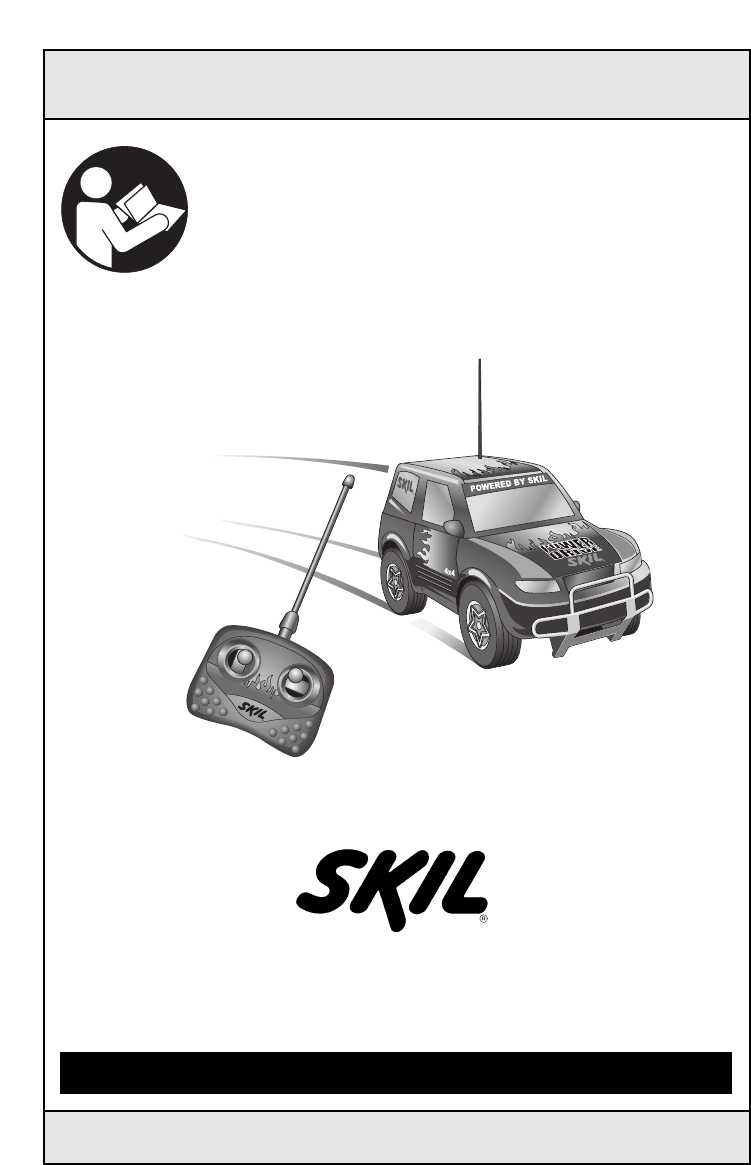
IMPORTANT: IMPORTANT : IMPORTANTE:
Read Before Using Lire avant usage Leer antes de usar
Operating/Safety Instructions
Consignes de fonctionnement/sécurité
Instrucciones de funcionamiento y seguridad
For English Version Version française Versión en español
See page 2 Voir page 9 Ver la página 14
1-877-SKIL999 (1-877-754-5999) www.skil.com
Call Toll Free for
Consumer Information
&Service Locations
Pour obtenir des informations
et les adresses de nos centres
de service après-vente,
appelez ce numéro gratuit
Llame gratis para
obtener información
para el consumidor y
ubicaciones de servicio

Use only with Skil battery 120BAT or
144BAT. See instructions and warnings
that came with power tool for battery care
and recharging instructions. Only adults
should recharge battery and install
battery into car.
CHOKING HAZARD - Small parts. Not for
children under 3 yrs.
This car is recommended for children
over the age of 8 years old.
Use only alkaline 9v battery in remote
control unit.
Do not short circuit terminals of either
battery. Fire or serious injury may result.
-2-
Battery/Charger
Before using battery charger, read all
instructions and cautionary markings on
(1) battery charger, (2) battery pack, and
(3) product using battery.
Use only the charger which accompanied
your product or direct replacement as
listed in the catalog or this manual. Do not
substitute any other charger. Use only Skil
approved chargers with your product. See
Functional Description and Specifications.
Do not disassemble charger or operate the
charger if it has received a sharp blow,
been dropped or otherwise damaged in
any way. Replace damaged cord or plugs
immediately. Incorrect reassembly or
damage may result in electric shock or fire.
Do not recharge battery in damp or wet
environment. Do not expose charger to
rain or snow. If battery case is cracked or
otherwise damaged, do not insert into
charger. Battery short or fire may result.
Charge only Skil approved rechargeable
batteries. See Functional Description and
Specifications. Other types of batteries may
burst causing personal injury and damage.
Charge battery pack in temperatures
above +40 degrees F (4 degrees C) and
below +105 degrees F (41 degrees C).
Store tool and battery pack in locations
where temperatures will not exceed 120
degrees F (49 degrees C). This is important
to prevent serious damage to the battery
cells.
Battery leakage may occur under extreme
usage or temperature conditions. Avoid
contact with skin and eyes. The battery
liquid is caustic and could cause chemical
burns to tissues. If liquid comes in contact
with skin, wash quickly with soap and water,
then with lemon juice or vinegar. If the liquid
contacts your eyes, flush them with water for
aminimum of 10 minutes and seek medical
attention.
Place charger on flat non-flammable
surfaces and away from flammable
materials when re-charging battery pack.
The charger and battery pack heat during
charging. Carpeting and other heat insulating
surfaces block proper air circulation which
may cause overheating of the charger and
battery pack. If smoke or melting of the case
are observed unplug the charger immediately
and do not use the battery pack or charger.
Use of an attachment not recommended
or sold by Skil may result in a risk of fire,
electric shock or injury to persons.
Safety Rules
Read instructions for this radio controlled car, battery and charger before
operating toy.
SAVE THESE INSTRUCTIONS
!
WARNING
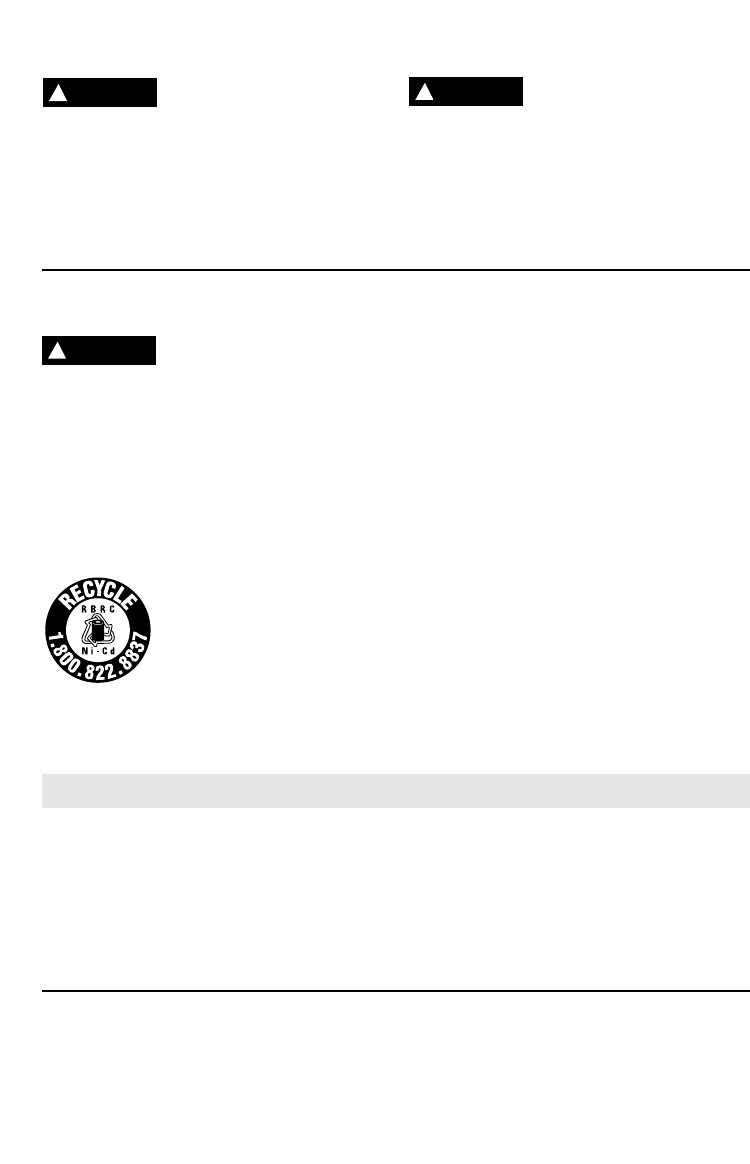
-3-
When batteries are not in
tool or charger, keep them
away from metal objects. For example, to
protect terminals from shorting DO NOT place
batteries in a tool box or pocket with nails,
screws, keys, etc. Fire or injury may result.
To prevent fire or injury
when batteries are not in
tool or charger, always place protective
cap onto end of battery pack. Protective
cap, guards against terminal shorting.
DO NOT PUT BATTERIES INTO FIRE OR
EXPOSE TO HIGH HEAT. They may
explode.
Do not attempt to
disassemble the battery or
remove any component projecting from
the battery terminals. Fire or injury may
result. Prior to disposal, protect exposed
terminals with heavy insulating tape to
prevent shorting.
NICKEL-CADMIUM BATTERIES
If equipped with a nickel-cadmium battery, the
battery must be collected, recycled or
disposed of in an environmentally sound
manner.
“The EPA certified RBRC
Battery Recycling Seal on the
nickel-cadmium (Ni-Cd)
battery indicates Robert
Bosch Tool Corporation is
voluntarily participating in an
industry program to collect and recycle these
batteries at the end of their useful life, when
taken out of service in the United States or
Canada. The RBRC program provides a
convenient alterative to placing used Ni-Cd
batteries into the trash or the municipal waste
stream, which may be illegal in your area.
Please call 1-800-8-BATTERY for information
on Ni-Cd battery recycling and disposal
bans/restrictions in your area, or return your
batteries to a Skil/Bosch/Dremel Service
Center for recycling. Robert Bosch Tool
Corporation’s involvement in this program is
part of our commitment to preserving our
environment and conserving our natural
resources.”
!
WARNING
!
WARNING
Battery Care
Battery Disposal
!
WARNING
Sometimes erratic behavior or loss of control
of the car is the result of interference which is
caused by high tension wires, high-voltage
transformers, certain types of buildings,
concrete walls or narrow places where radio
signals can be easily affected; if you
encounter this type of behavior or loss of
control, change to a different location for
playing the toy.
You may encounter interference if another
radio-controlled car or CB radio is operating
in the vicinity on your same frequency
Radio Interference
FCC CAUTION:
The manufacturer is not responsible for radio interference caused by unauthorized
modifications to this equipment. Such modifications could void the user’s authority to operate
the equipment.
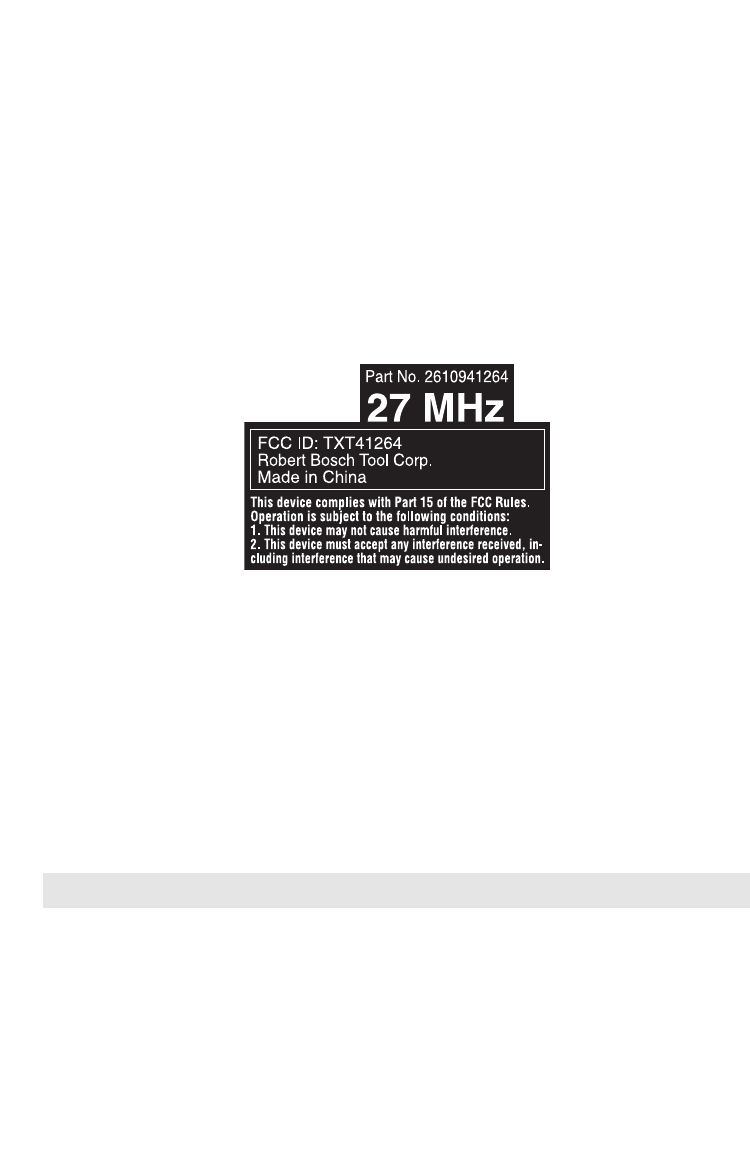
-4-
When not in use, turn the power switch off.
Remove the battery pack and the 9V battery
after use in order to prevent any possible
leakage.
When the car slows down, or the control range
decreases, it is time for recharging the battery
pack or replacing the 9V battery.
If the car moves poorly and you have installed a
fresh battery pack, check if the wheels have
picked up lint (lint, threads, hair and dust in the
wheel bearings slow down the car); carefully
remove such materials from the wheel bearings.
Remove battery pack from car before checking.
Hints & Tips
NOTE: This equipment has been tested and
found to comply with the limits for a Class B
digital device, pursuant to part 15 of the FCC
Rules. These limits are designed to provide
reasonable protection against harmful
interference in a residential installation. This
equipment generates, uses and can radiate
radio frequency energy and, if not installed
and used in accordance with the instructions,
may cause harmful interference to radio
communications. However, there is no
guarantee that interference will not occur in a
particular installation. If this equipment does
cause harmful interference to radio or
television reception, which can be determined
by turning the equipment off and on, the user
is encouraged to try to correct the
interference by one or more of the following
measures:
• Reorient or relocate the receiving antenna.
• Increase the separation between the
equipment and receiver.
• Connect the equipment into an outlet on a
circuit different from that to which the
receiver is connected.
• Consult the dealer or an experienced
radio/TV technician for help.
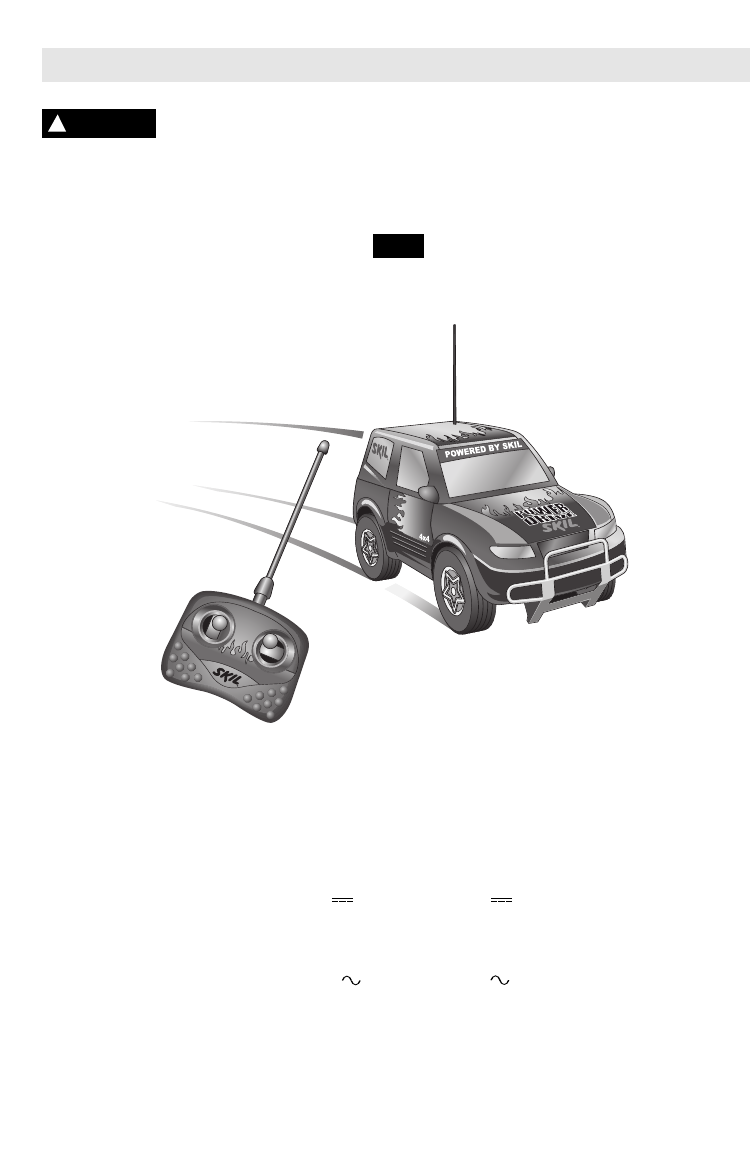
-5-
Car
Model number 2610937482
Frequency 27MHz
Functions Forward Left/Right, Reverse Left/Right
Voltage rating 12V 14.4V
Charge time 3 hr. 3 hr.
Charger 92490 92590
Voltage rating 120 V 60 Hz 120 V 60 Hz
Battery pack 120BAT 144BAT
Functional Description and Specifications
Disconnect battery pack from car or place the switch in the off position
before making any assembly or adjustments.Such preventive safety
measures reduce the risk of starting the car accidentally.
!
WARNING
Radio-Controlled Car
FIG. 1
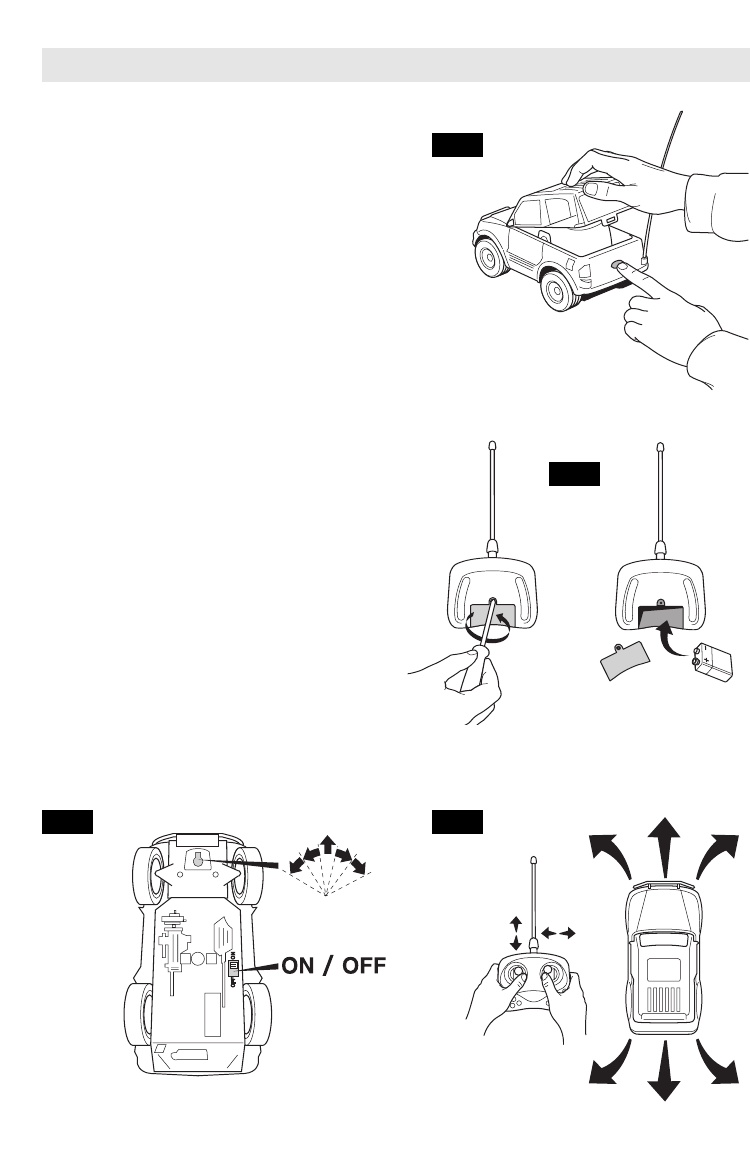
-6-
Operating Instructions
Battery Installation
Only use the battery packs and batteries
specified.
Mounting battery pack in car:
1. Open top cover of the car, by pressing tab
release button at rear of car, figure 2.
2. Connect a charged SKIL battery pack to
the plug of the car
3. Replace the top of the car
Mounting battery in Transmitter:
1. Unscrew and remove battery cover located
on the back of the transmitter, as shown in
figure 3.
2. Install one 9V battery.
3. Replace the cover.
Operation
1. Set the power switch of the car to “ON”,
figure 4.
2. Use of Transmitter, figure 5:
• Press the left stick up or down for
forward or reverse motion.
• Press the right stick right or left to steer
the car.
3. If the car fails to go straight, adjust the
neutral steering alignment, figure 4.
FIG. 2
FIG. 3
FIG. 4 FIG. 5
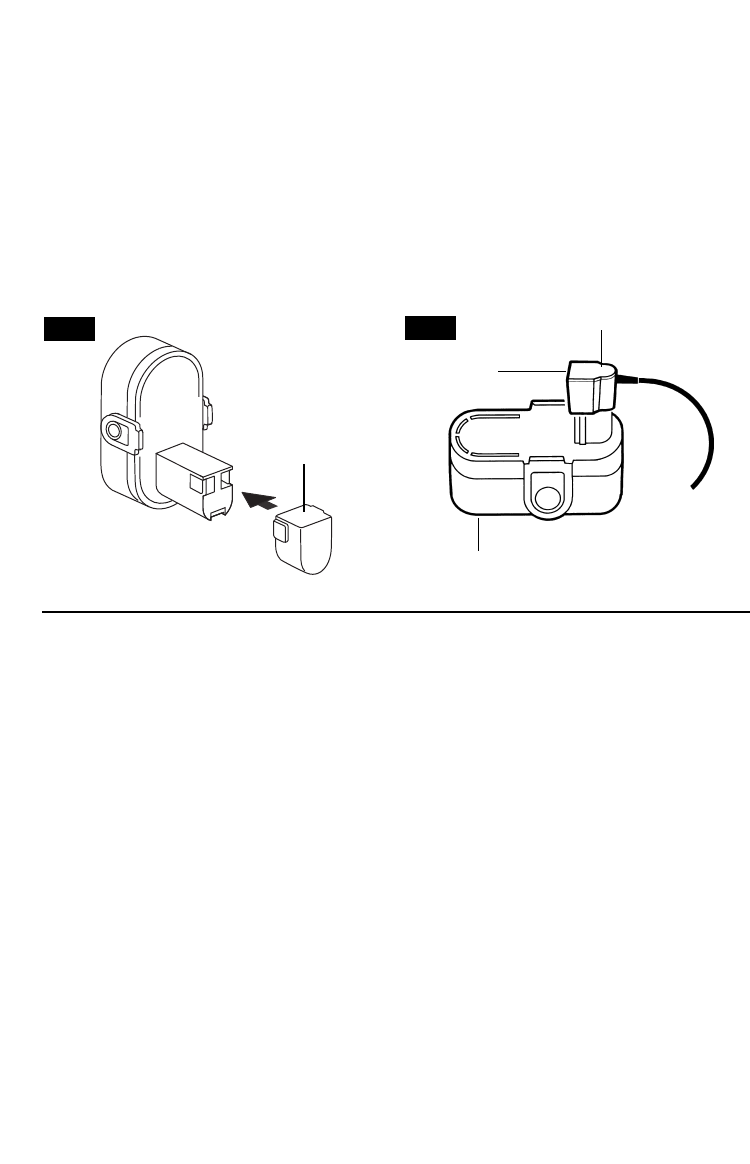
-7-
1. The battery pack accepts only about 80%
of its maximum capacity with its first few
charge cycles. However, after the first few
charge cycles, the battery will charge to full
capacity.
2. The charger was designed to fast charge
the battery only when the battery
temperature is between 40˚F (4˚C) and
105˚F (41˚C).
3. A substantial drop in operating time per
charge may mean that the battery pack is
nearing the end of its life and should be
replaced.
4. If you anticipate long periods (i.e. a month or
more) of non-use of your tool, it is best to
run your tool down until it is fully discharged
before storing your battery pack. After a long
period of storage, the capacity at first
recharge will be lower. Normal capacity will
be restored in two or three charge/discharge
cycles. Remember to unplug charger during
storage period.
5. If battery does not charge properly:
a. Check for voltage at outlet by plugging
in some other electrical device.
b. Check to see if outlet is connected to a
light switch which turns power “off” when
lights are turned off.
c. Check battery pack terminals for dirt.
Clean with cotton swab and alcohol if
necessary.
d. If you still do not get proper charging,
take or send tool, battery pack and charger to
your local Skil Service Center. See “Tools,
Electric” in the Yellow Pages for names and
addresses.
Note: Use of charger’s or battery packs not
sold by Skil will void the warranty.
IMPORTANT CHARGING NOTES
Plug charger cord into your standard power
outlet. Before inserting battery pack, remove
protective cap, then insert battery pack into
charger (Fig. 6).
The charger’s green light (Fig. 7), will turn
“ON”. The green light remains ‘‘ON’’ as long as
charger is plugged in, and does not shut off.
After normal usage, the battery pack requires
approximately 3 hours or less charging time
to become fully charged. If the battery pack
is run-down completely, it may require up to
5hours charging time to become fully
charged.
When the battery pack is fully charged,
unplug the charger (unless you're charging
another battery pack) and slip the battery
pack back into the tool handle.
To prevent fire or injury when batteries are
not in tool or charger, always place protective
cap onto end of battery pack.
INDICATOR
LIGHT
BATTERY PACK
CHARGER
CHARGING BATTERY PACK (3 HOUR CHARGER)
PROTECTIVE
CAP
FIG. 6 FIG. 7
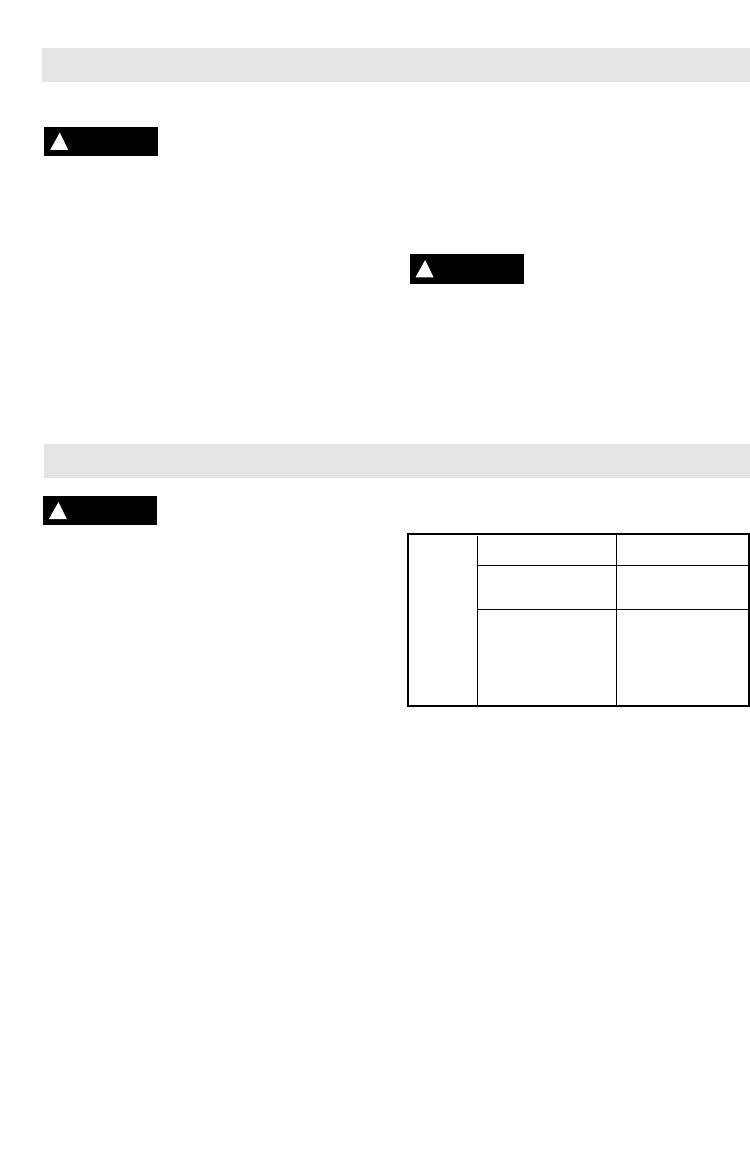
-8-
Accessories
If an extension cord is
necessary, a cord with
adequate size conductors that is capable
of carrying the current necessary for your
tool must be used. This will prevent
excessive voltage drop, loss of power or
overheating. Grounded tools must use 3-wire
extension cords that have 3-prong plugs and
receptacles.
NOTE: The smaller the gauge number, the
heavier the cord.
RECOMMENDED SIZES OF EXTENSION CORDS
120 VOLT ALTERNATING CURRENT TOOLS
!
WARNING
Service
NO USER SERVICEABLE
PARTS INSIDE. Call toll free
for consumer Information: 1-877-SKIL999 (1-
877-754-5999)
BATTERIES
Be alert for battery packs that are nearing
their end of life. If you notice decreased tool
performance or significantly shorter running
time between charges then it is time to
replace the battery pack. Failure to do so can
cause the tool to operate improperly or
damage the charger.
Long term battery storage should be in
the discharged state. Battery packs last
longer and re-charge better when they are
stored discharged. Remember to fully re-
charge battery packs before using after
prolonged storage.
Cleaning
Certain cleaning agents
and solvents damage
plastic parts. Some of these are: gasoline,
carbon tetrachloride, chlorinated cleaning
solvents, ammonia and household detergents
that contain ammonia.
!
WARNING
!
WARNING
Maintenance
Tool’s
Ampere
Rating
Cord Size in A.W.G. Wire Sizes in mm2
3-6
6-8
8-10
10-12
12-16
18 16 16 14 0.75 0.75 1.5 2.5
18 16 14 12 0.75 1.0 2.5 4.0
18 16 14 12 0.75 1.0 2.5 4.0
16 16 14 12 1.0 2.5 4.0 —
14 12 — — — — — —
25 50 100 150 15 30 60 120
Cord Length in Feet Cord Length in Meters